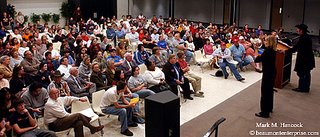
Kinky Friedman campaigns for Texas Governor at Lamar University in Beaumont on Monday, Oct. 23, 2006.
Photos by Mark M. Hancock / © The Beaumont Enterprise

Comedian and singer Kinky Friedman campaigns for Texas Governor at Lamar University.

A relatively large audience listens as Kinky Friedman (right) campaigns for Texas Governor at Lamar University.
Earlier this month, I stated PJs often don't know how images will be laid out on a page. Consequently, it's best to present both horizontal and vertical options to the layout desk. It's also good to give the layout desk left, right, center and behind options if possible.
The top two images are similar, however PJs can give layout the option of left or right orientation. This is particularly important on assignments near deadlines. Page designers make the page with a hole for the image. PJs can ask if the hole is on the left or right-hand side of the page and deliver the appropriate image without layout needing to rearrange the text (and possibly create other design problems).
In the example above, we also have the option of horizontal or vertical. All four options (VL, VR, HL, HR) were shot and available, but this post is redundant enough. ;-}
Although it would be ideal to manage to have equally "useful" shots from both sides, it's important to understand the PJ (or photo editor) can change the entire deal. If one image is much better than the others, the image determines layout. The best image always trumps layout decisions.
If all options are about equally publishable, give the desk what works best for it.
Get the options
When covering a speaker (or singer) at a microphone, the first objective is to get the mic out of the person's mouth (or nose). This is best accomplished from the sides. Occasionally, the entire mic can be cropped in-camera. Otherwise, its interference is minimized by the angle.
To get both left and right angles, the PJ needs to move to the opposite side of the stage. The speaker continues to look forward. For PJs, s/he is looking both directions depending on shooting angle.
The third option above is tricky for some folks. Whenever possible, try to work the speaker and the audience into the same shot to show turnout. In the image above, he had a fairly good audience in a relatively small room.
I'll write about "shooting blind" sometime soon to explain how this angle is accomplished.
Enough for now,


No comments:
Post a Comment